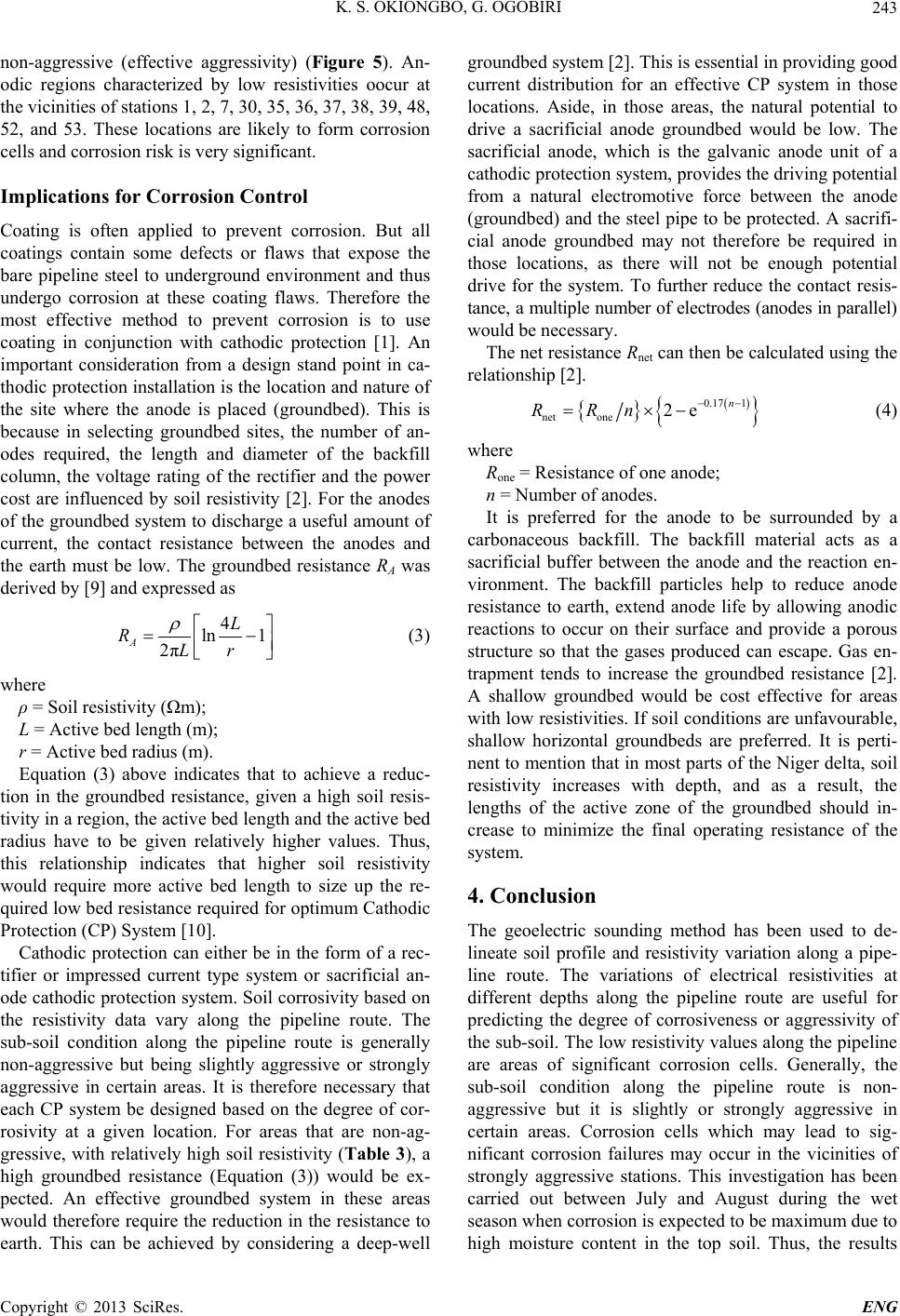
K. S. OKIONGBO, G. OGOBIRI 243
non-aggressive (effective aggressivity) (Figure 5). An-
odic regions characterized by low resistivities oocur at
the vicinities of stations 1, 2, 7, 30, 35, 36, 37, 38, 39, 48,
52, and 53. These locations are likely to form corrosion
cells and corrosion risk is very significant.
Implications for Corrosion Control
Coating is often applied to prevent corrosion. But all
coatings contain some defects or flaws that expose the
bare pipeline steel to underground environment and thus
undergo corrosion at these coating flaws. Therefore the
most effective method to prevent corrosion is to use
coating in conjunction with cathodic protection [1]. An
important consideration from a design stand point in ca-
thodic protection installation is the location and nature of
the site where the anode is placed (groundbed). This is
because in selecting groundbed sites, the number of an-
odes required, the length and diameter of the backfill
column, the voltage rating of the rectifier and the power
cost are influenced by soil resistivity [2]. For the anodes
of the groundbed system to discharge a useful amount of
current, the contact resistance between the anodes and
the earth must be low. The groundbed resistance RA was
derived by [9] and expressed as
4
ln 1
2
A
L
RLr
(3)
where
ρ = Soil resistivity (m);
L = Active bed length (m);
r = Active bed radius (m).
Equation (3) above indicates that to achieve a reduc-
tion in the groundbed resistance, given a high soil resis-
tivity in a region, the active bed length and the active bed
radius have to be given relatively higher values. Thus,
this relationship indicates that higher soil resistivity
would require more active bed length to size up the re-
quired low bed resistance required for optimum Cathodic
Protection (CP) System [10].
Cathodic protection can either be in the form of a rec-
tifier or impressed current type system or sacrificial an-
ode cathodic protection system. Soil corrosivity based on
the resistivity data vary along the pipeline route. The
sub-soil condition along the pipeline route is generally
non-aggressive but being slightly aggressive or strongly
aggressive in certain areas. It is therefore necessary that
each CP system be designed based on the degree of cor-
rosivity at a given location. For areas that are non-ag-
gressive, with relatively high soil resistivity (Table 3), a
high groundbed resistance (Equation (3)) would be ex-
pected. An effective groundbed system in these areas
would therefore require the reduction in the resistance to
earth. This can be achieved by considering a deep-well
groundbed system [2]. This is essential in providing good
current distribution for an effective CP system in those
locations. Aside, in those areas, the natural potential to
drive a sacrificial anode groundbed would be low. The
sacrificial anode, which is the galvanic anode unit of a
cathodic protection system, provides the driving potential
from a natural electromotive force between the anode
(groundbed) and the steel pipe to be protected. A sacrifi-
cial anode groundbed may not therefore be required in
those locations, as there will not be enough potential
drive for the system. To further reduce the contact resis-
tance, a multiple number of electrodes (anodes in parallel)
would be necessary.
The net resistance Rnet can then be calculated using the
relationship [2].
0.17 1
net one2e n
RRn
(4)
where
Rone = Resistance of one anode;
n = Number of anodes.
It is preferred for the anode to be surrounded by a
carbonaceous backfill. The backfill material acts as a
sacrificial buffer between the anode and the reaction en-
vironment. The backfill particles help to reduce anode
resistance to earth, extend anode life by allowing anodic
reactions to occur on their surface and provide a porous
structure so that the gases produced can escape. Gas en-
trapment tends to increase the groundbed resistance [2].
A shallow groundbed would be cost effective for areas
with low resistivities. If soil conditions are unfavourable,
shallow horizontal groundbeds are preferred. It is perti-
nent to mention that in most parts of the Niger delta, soil
resistivity increases with depth, and as a result, the
lengths of the active zone of the groundbed should in-
crease to minimize the final operating resistance of the
system.
4. Conclusion
The geoelectric sounding method has been used to de-
lineate soil profile and resistivity variation along a pipe-
line route. The variations of electrical resistivities at
different depths along the pipeline route are useful for
predicting the degree of corrosiveness or aggressivity of
the sub-soil. The low resistivity values along the pipeline
are areas of significant corrosion cells. Generally, the
sub-soil condition along the pipeline route is non-
aggressive but it is slightly or strongly aggressive in
certain areas. Corrosion cells which may lead to sig-
nificant corrosion failures may occur in the vicinities of
strongly aggressive stations. This investigation has been
carried out between July and August during the wet
season when corrosion is expected to be maximum due to
high moisture content in the top soil. Thus, the results
Copyright © 2013 SciRes. ENG